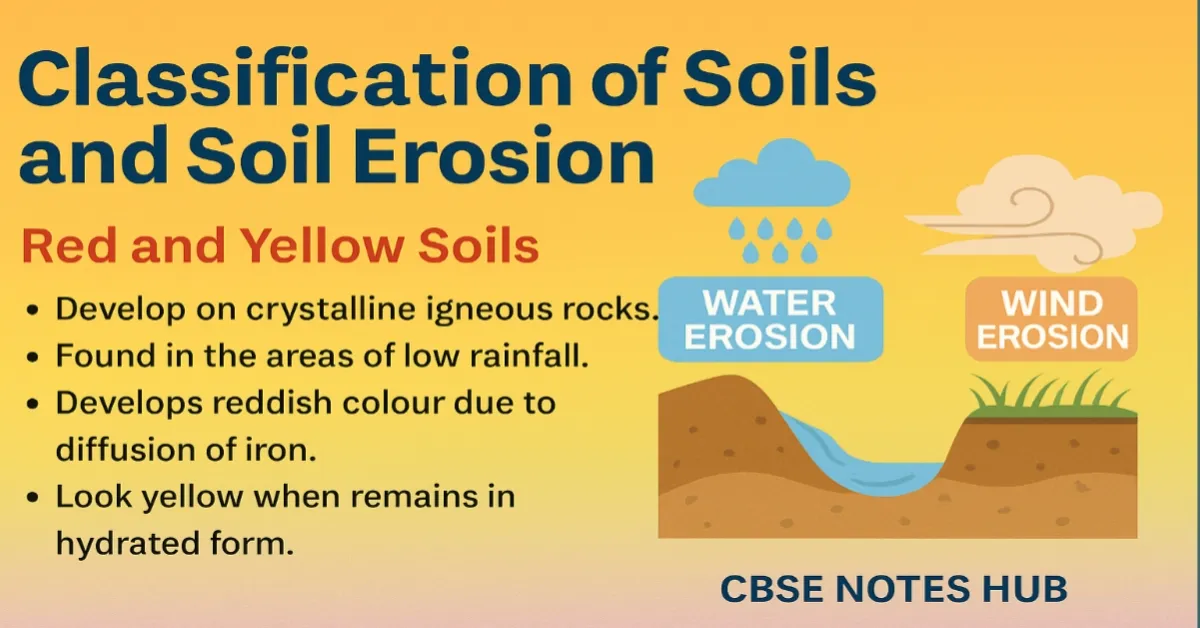“Classification of Soils and Soil Erosion” form a vital part of understanding our natural resources and their sustainable use. In this section, we will explore the different types of soils found in India, such as Red and Yellow soils, Laterite soils, Arid soils, and Forest soils. We will also examine the causes and types of soil erosion, along with practical soil conservation methods. Building on the concepts discussed in Part 3: Land Degradation and Conservation, Alluvial Soil and Black Soil, this section aims to provide a deeper understanding of how natural and human activities impact land resources and how we can manage them sustainably. This detailed overview will help students develop a comprehensive knowledge base for geography and environmental studies.
Easy and Quick Notes Ch. 1
Resource and development
Part – 4
Classification of Soils
Red and Yellow Soils
These soils –
- Develop on crystalline igneous rocks.
- Found in the areas of low rainfall.
- Develops reddish colour due to diffusion of iron.
- Look yellow when remains in hydrated form.
- Found in eastern and southern part of the Deccan plateau, Odisha, Chhattisgarh, piedmont zone plains of Western Ghats and southern parts of middle Ganga plain.
- Crops like maize and pulses can be grown on this soil.
Laterite soil –
- Develops in the area of high temperature and high rainfall.
- Formed due to intense leaching.
- Humus content is low.
- Found in Karnataka, Tamil Nadu, Madhya Pradesh, Maharashtra, Odisha, some parts of West Bengal and North-east regions.
- Suitable for the production of tea and coffee in Kerala, Assam, and Tamil Nadu (Kashmir, Tamil Nadu, Andhra Pradesh and Kerala).
- Suitable for cultivation with adequate doses of fertiliser.
Arid Soils
- Red to brown in colour.
- Texture – sandy
- Nature – saline
- Low humus content
- Kankar in lower horizons hence restrict infiltration.
- Becomes cultivable after proper irrigation (as in western Rajasthan).
Found in Rajasthan.
Crops – Bajra, maize.
Forest Soils
- Found in hilly and mountain areas.
- Loamy and silty in valley sides; coarse-grained in upper slopes.
- In the snow-covered areas of Himalayas, these soils experience denudation and are acidic with low humus content.
- Found mainly in the lower parts of the valleys.
Soil Erosion
The removal of top fertile soil cover by natural or human factors is called soil erosion.
Human factors which lead to soil erosion:
- Deforestation
- Overgrazing
- Construction
- Mining etc.
- Defective methods of farming
- Ploughing in a wrong way
Natural factors which lead to soil erosion:
- Wind
- Water
- Glaciers <
- Sheet erosion:
- Common in hilly areas.
- Water flows down as a sheet and washes away the topsoil over a large area.
- Gully erosion:
- Occurs due to action of running water in clayey soils.
- Due to formation of deep channels or gullies the land becomes unfit for cultivation and is known as bad land.
- Afforestation
- Contour Ploughing – Ploughing along the contour lines
- Strip Cropping – Strips of grass are left to grow between the crops
- Shelter belts – Planting lines of trees to reduce force of wind
Types of Soil Erosion
Water erosion : Soil erosion caused by water.
Types of water erosion
Wind erosion : Removal of topsoil by fast flowing winds.
Methods of Soil Conservation
Before moving to the FAQs, you can also check out our detailed post on Power Sharing Class 10 Important Questions and Answers. Here are some FAQs which will clear your doubts related to this topic.
Q1. On which type of rocks do Red and Yellow soils develop?
A1. Crystalline igneous rocks.
Q2. In which regions are Red and Yellow soils found?
A2. Eastern and southern parts of the Deccan plateau, Odisha, Chhattisgarh, piedmont zone plains of Western Ghats, and southern parts of the middle Ganga plain
Q3. What is the colour of Arid soils?
A3. Red to brown.
Q4. What is the texture of Arid soils?
A4. Sandy.
Q5. Name the soil that has low humus content and is found in Rajasthan.
A5. Arid soils.
Q6. In which areas are Forest soils found?
A6. Hilly and mountain areas.
Q7. What is soil erosion?
A7. The removal of top fertile soil cover by natural or human factor
Q8. Name one human factor that leads to soil erosion.
A8. Deforestation.
Q9. Name one natural factor that leads to soil erosion.
A9. Wind.
Q10. What is sheet erosion?
A10. Water flows down as a sheet and washes away the topsoil over a large area.
Let’s wind it up
Understanding the Classification of Soils and Soil Erosion is essential for building a strong foundation in Class 10 Geography. We have discussed various types of soils in India, their unique characteristics, and how human and natural factors contribute to soil erosion. These concepts help students appreciate the need for sustainable soil management. To explore related topics and strengthen your knowledge base, feel free to visit CBSE Notes Hub and continue your learning journey.


